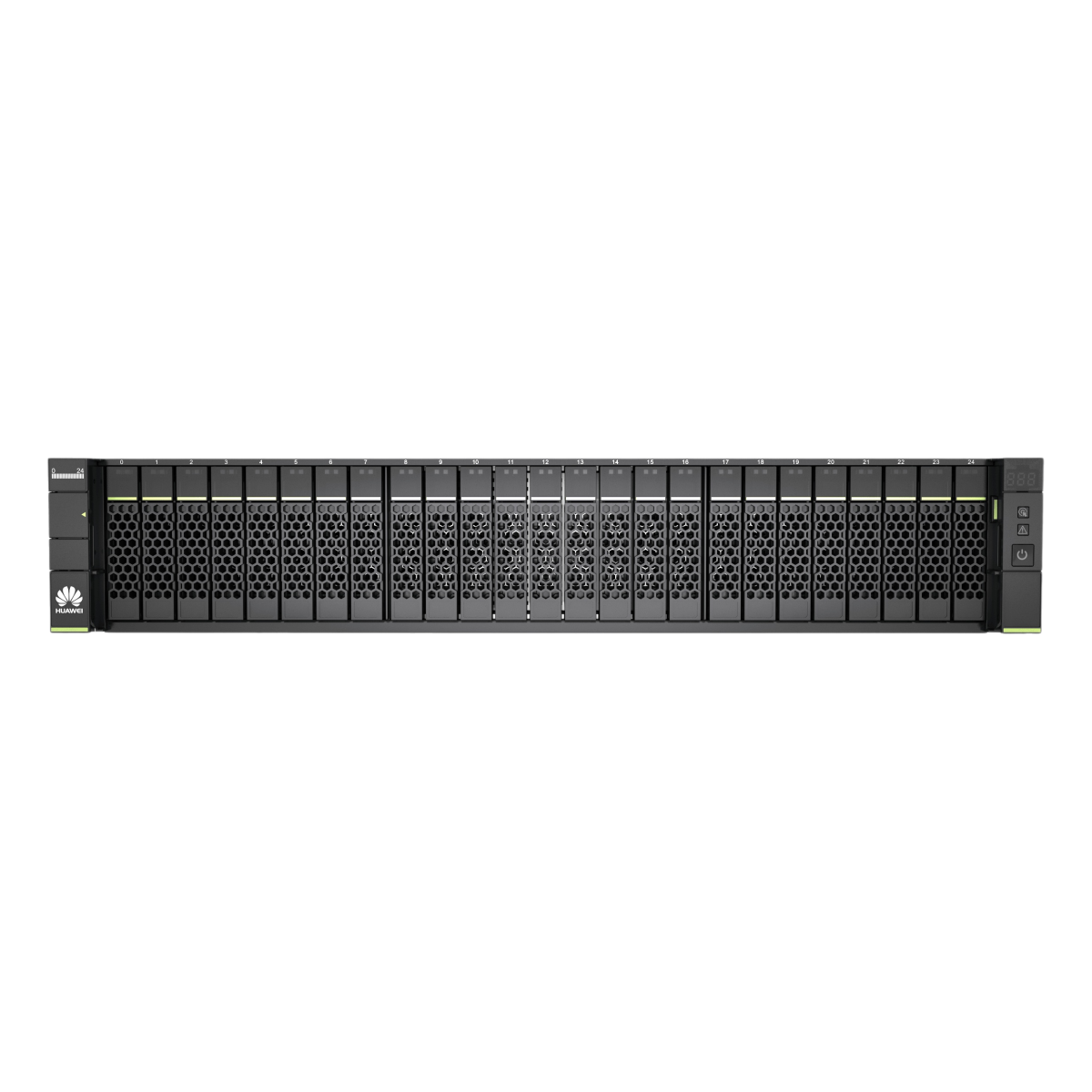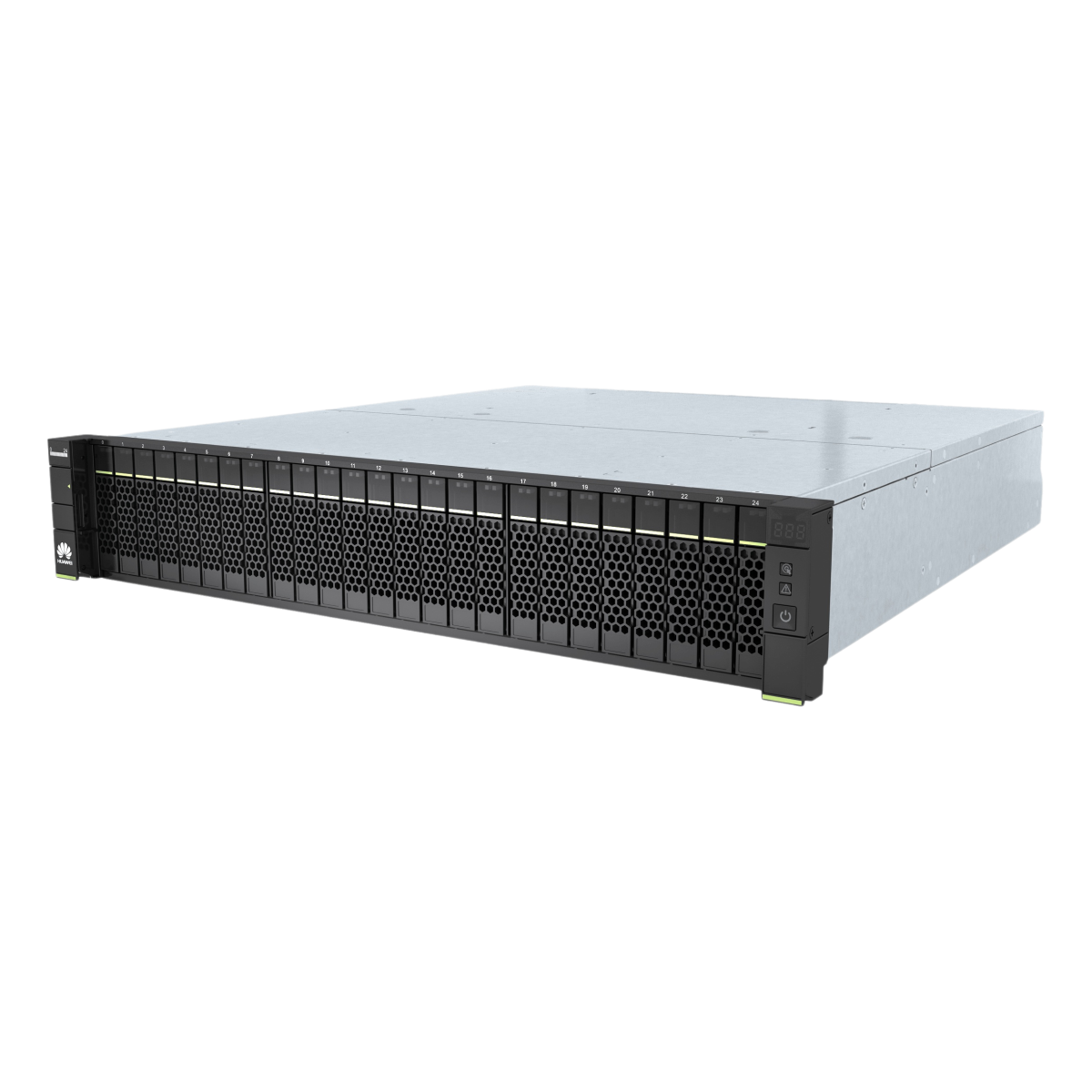The OceanStor 2600 V3 storage system is a Huawei next-generation storage product designed for midtier-to-enterprise storage environments. It provides mass data storage, fast data access, and high utilization in the ease-of-use and energy saving form factor.
Condition: NOB
RMA Warranty
Description
Product Features
Designed for midtier-to-enterprise storage environments, the OceanStor 2600 V3 storage system utilizes high-specification hardware and is available in block, file, and unified configurations. It offers significant advancements in data applications and protection and provides the following benefits:
Unified Storage
- Support for SAN and NAS storage technologies
Unifies SAN and NAS technologies to store both structured and unstructured data.
- Support for mainstream storage protocols
Supports mainstream storage protocols such as iSCSI, Fibre Channel, NFS, CIFS, HTTP, and FTP.
High Performance
The OceanStor 2600 V3 storage system offers a three-level performance acceleration technology, and delivers hierarchical performance for different applications. The three levels are:
- State-of-the-art hardware
The OceanStor 2600 V3 storage system is equipped with 64-bit multi-core processors, high-speed and large-capacity caches, and various high-speed interface modules. The superior hardware allows it to offer better storage performance than tradition storage systems.
- SmartTier
The SmartTier technology identifies hotspot data and periodically promotes them to high-performance storage medium for a performance boost. In addition, SmartTier supports solid state drive (SSD) data caching, accelerating access to hotspot data.
- SSDs
The OceanStor 2600 V3 storage system can be fully configured with SSDs to provide peak performance for the most-demanding applications.
Flexible Scalability
The OceanStor 2600 V3 storage system has an outstanding scalability. It supports a wide range of the following disks and host interface modules in a high density:
- Disks:
SAS disks, NL-SAS disks, and SSDs.
- Host interface modules:
8 Gbit/s Fibre Channel, GE, 10GE, and SmartIO.
SmartIO interface modules support various port types including 8 Gbit/s Fibre Channel, 16 Gbit/s Fibre Channel, 10 Gbit/s FCoE (VN2VF), 10 Gbit/s Ethernet, and iWARP (interconnection between Scale-out nodes).
The OceanStor 2600 V3 storage system also supports Scale-out expansion of clustered nodes for system performance improvement.
Proven Reliability
The OceanStor 2600 V3 storage system uses advanced technologies to offer protection measures, minimizing risks of failures and data loss.
- Protection against component failures
The storage system components are in 1+1 redundancy and work in active-active mode. Normally, every two components work simultaneously and share loads. If one component fails or goes offline, the other one takes over all loads and speeds up to compensate. The whole process is transparent to applications.
- RAID 2.0+ underlying virtualization
The storage system employs innovative RAID 2.0+ underlying virtualization technology for automatic load balancing. If a disk encounters a fault, all the other disks in the same disk domain help construct the faulty disk’s service data, achieving a 20-fold faster reconstruction speed than traditional RAID technology. In addition, RAID 2.0+ significantly reduces the possibility of multi-disk failure.
- Data protection in the event of a controller failure
- Built-in backup power modules supply power to controller enclosures in the event of unexpected power failures. They enable cache data to be written to built-in disks of controllers to avoid data loss.
- When a piece of software is faulty, the storage system will attempt to reboot. During the reboot, data is stored in the cache. If the reboot fails, data in the cache will be written into the built-in disks of controllers to avoid data loss.
- If hardware of a controller is faulty, the storage system will use the memory mirroring technology to enable the other normal controller to take over the services to ensure data consistency.
- Bad sector repair
In a storage system, the frequently occurred fault is bad sectors of disks. The OceanStor 2600 V3 storage system adopts the bad sector repair technology to proactively detect and repair bad sectors, reduce the disk failure rate by 50%, and prolong the service life of disks.
- Disk pre-copy
The disk pre-copy technology enables the storage system to routinely check the hardware status. Once it detects that a disk has fault risks, it will enable data migration from the disk to another normal disk to prevent data loss.
- IP failover
The storage system adopts IP failover technology. If a physical host port that implements the NAS protocol is damaged, the IP address assigned to that port automatically fails over to another functional port. Based on the correct networking, services are seamlessly failed over, preventing damage to a port from affecting services.
- Online disk diagnosis
The online disk diagnosis feature is used to handle disk faults. If a disk fault occurs, the storage system takes the disk offline. Then, the online diagnosis module reads the S.M.A.R.T information about the disk and takes analysis, testing, and recovery measures. After the disk is recovered, the online diagnosis module enables the disk to rejoin the RAID, prolonging the lifecycle of the disk.
- Data coffer disk
Data coffer disks consist of the first four disks of a storage system’s controller enclosure as well as the controller’s two built-in disks. They store three types of data: cache data requiring power failure protection, OceanStor OS system data, and system configuration information and logs.
High Availability
In routine maintenance:
The OceanStor 2600 V3 storage system uses Turbo Module, online capacity expansion, and disk roaming technologies to provide high availability for applications and nonstop system running during maintenance.
- Turbo Module enables controllers, fans, power modules, interface modules, and disks to be hot-swappable, allowing online operations.
- Dynamic capacity expansion enables users to add disks to a disk domain in an online and easy manner.
- Disk roaming enables a storage system to automatically identify relocated disks and resume their services.
In data protection:
The OceanStor 2600 V3 storage system provides the following advanced data protection technologies and protocols to protect data integrity and continuous system running even when catastrophic disasters happen:
- Snapshot generates multiple point-in-time images for the source logical unit number (LUN) or source file system data. The snapshot images can be used to recover data quickly when needed.
- LUN copy backs up data among heterogeneous storage systems for data protection.
- Remote replication backs up local data onto a remote storage system for disaster recovery.
- Clone preserves a real-time physical copy of a source LUN or file systemfor the high availability of local data.
- HyperMirror backs up data in real time. If the source data becomes unavailable, applications can automatically use the data copy, ensuring data security and business continuity.
- HyperMetro synchronizes and replicates data between storage arrays, monitors service operating status, and performs failovers. In addition, it can switch over services and implement service load sharing when storage arrays are running.
- The storage system supports Network Data Management Protocol (NDMP) for data backup and recovery.
In resource management:
The OceanStor 2600 V3 storage system employs the following resource application technologies and provides flexible resource management to protect customers’ storage investments:
- SmartVirtualization enables a local storage system to centrally manage storage resources of heterogeneous storage systems, simplifying storage system management and reducing maintenance costs.
- SmartMigration migrates LUNs or file systems in or between storage systems, adjusting and allocating resources along with business development.
- SmartMulti-Tenant enables a storage system to provide different tenants with shared storage resources and to separate tenant access and management.
The OceanStor 2600 V3 storage system supports memory upgrade so that storage performance matches service development.
High System Security
Storage network security:
- Security of management channels
The management operations from physical ports are controlled by the access authentication mechanism of the storage system, and only authorized users are allowed to manage the storage system.
- Anti-attack protection for protocols and ports
The storage system provides only necessary ports to the external for system operations and maintenance. All the ports used are listed in the Communication Matrix. Dynamic listening ports are functioning in the proper scope, and no undisclosed interface exists.
- Service ports are isolated from management ports
The Access Control List (ACL) mechanism is adopted to isolate Ethernet ports from internal heartbeat network ports, management network ports, and maintenance network ports.
Storage service security:
- Security of the operating system
The storage system uses a dedicated operating system. Security of the operating system has been hardened before the storage system is delivered. The storage systems update security patches for their operating systems and open-source software based on site requirements, safeguarding users’ data.
- Data storage encryption
The storage system supports disk encryption. The hardware circuits and internal data encrypt key of disks are used for data writing encryption and data reading decryption. To ensure the security of data encrypt key, the storage system and the third-party key management server jointly provide a highly secure, reliable, and available key management solution.
- Data destruction
When deleting unwanted data, the system erases the specified LUN to make the deleted data unable to be restored, preventing critical data leaks.
- File antivirus
When the storage system runs a file system and shares the file system with clients through CIFS, third-party antivirus software can be used to trigger virus scanning and delete virus-infected files, improving storage system security.
Storage management security:
- Security of management and maintenance
The operations of users can be allowed and denied. All management operations are logged by the system.
- Data integrity protection and tamper resistance
The Write Once Read Many (WORM) feature allows users to set critical data to the read-only state, preventing unauthorized data change and deletion during a specified period of time.
Virtualization, Intelligence, and Efficiency
The OceanStor 2600 V3 storage system absorbs the concept of “Virtualization, Intelligence, and Efficiency”, which fits the up-to-date storage design idea and wins a leading position for the storage system. Compared with traditional storage systems, the storage system introduces the following technologies to provide higher storage space usage, faster data reconstruction, smarter performance allocation, and finer service quality control:
- RAID 2.0+ underlying virtualization
Divides disk storage space into small-sized data blocks and uses the blocks to create RAID groups for fine-grained resource management. The technology realizes automatic load balancing, higher storage performance, better storage space utilization, faster disk reconstruction, and finer storage space management. RAID 2.0+ serves as a basis for a number of other advanced storage technologies.
- SmartTier (intelligent storage tiering)
Enables a storage system to automatically analyze data access frequency per unit time and relocate data to disks of different performance levels based on the analysis result. High-performance disks store hot data, performance disks store warm data, and large-capacity disks store cold data. As a result, SmartTier optimizes overall performance and reduces costs per IOPS.
- SmartQoS (intelligent service quality control)
Enables a storage system to categorize service data based on data characteristics (each category represents a type of application) and set a priority and performance objective for each category. In this way, resources are assigned to services based on priorities, ensuring the performance of mission-critical services that have the top priority.
- SmartThin (intelligent thin provisioning)
Allows on-demand allocation of storage space rather than the traditional method of pre-allocating all storage space at the initial stage. It is more efficient because the amount of resources used is close to the amount of resources allocated. In this way, the initial purchase cost and total cost of ownership are reduced.
- SmartCache (intelligent storage cache)
Uses SSDs as cache resources to significantly promote system read performance when random, small I/Os with hot data require more read operations than write operations.
- Quick document incremental backup with Tivoli Storage Manager (TSM)
When the storage system interworks with the TSM backup software to perform incremental file backup, the Snapdiff feature uses the snapshot mechanism to quickly obtain differential file information and identify changed files. Without the need for full scanning, only changed files are backed, greatly shortening backup time. The backup performance is not affected by the number of files, which greatly improves the backup efficiency.
Cost-Effectiveness and Ease-of-Use
The OceanStor 2600 V3 storage system delivers cost-effective performance through intelligent CPU frequency control, delicate fan speed control, deduplication, and compression. It also provides a series of management and maintenance tools for easy use and maintenance.
- Cost-effectiveness
- Intelligent CPU frequency control
Automatically changes the CPU frequency based on the system loads. It decreases the CPU frequency and power consumption during off-peak hours for a low operation cost and long CPU service life.
- Delicate fan speed control
Dynamically adjusts the fan speed based on the storage system’s temperature. It lowers the noise and power consumption and cuts the operation cost.
- Deduplication and compression
Checks and processes duplicate data in disks based on deduplication, and minimizes space occupied by data based on compression to improve disk utilization.
- Intelligent CPU frequency control
- Ease-of-use
- DeviceManager
A tool based on the graphical user interface (GUI) allows you to easily manage storage systems through wizard-instructed operations.
- Storage resource configuration tool: SmartConfig
Installed on application servers, SmartConfig is a piece of software providing easy management of storage systems. With this tool, only three steps are needed to easily, flexibly, and effectively divide storage resources into disks and mount them to servers.
- Integrated management
Implements convenient device management by integrating a management plug-in into mainstream management software such as VMware vCenter plug-in, Hyper-V System Center, vSphere API for Storage Awareness (VASA), vSphere Storage APIs for Array Integration (VAAI), and Volume Shadow Copy Service (VSS) Provider.
- Tablet management
Supports flexible storage system management on a tablet.
- Various alarm notification methods
Provides alarm notification by sound, indicator, short message service (SMS), or email.
- Tool for an upgrade at your fingertip
Provides one-click online upgrade for controllers. The operation is easy without interrupting services.
- DeviceManager
Intelligent O&M
The eService intelligent cloud management system (eService for short) improves customers’ O&M capabilities and takes planned maintenance actions to prevent potential risks.
Being authorized by customers, eService monitors device alarms in 24/7 mode. Whenever an alarm is detected, eService automatically notifies Huawei technical support center and creates service requests (SRs). Huawei service engineers will help customers solve problems in a timely manner.
- eService provides a self-service O&M system for customers, aiming for precise and customized information services.
- Based on HUAWEI CLOUD, the eService cloud system drives IT O&M activities via big data analytics and artificial intelligence (AI) technologies to identify faults in advance, reduce O&M difficulties, and improve O&M efficiency.
- Data is encrypted during the data transmission, ensuring secure data transmission. eService can access the customer’s system only after being authorized by the customer.
- eService provides 24/7 secure, reliable, and proactive O&M services. SRs can be automatically created.
- Customers can use any PC to access eService at any time and any place to view device information.
eService enables the client system to work with the cloud system.
- eService client system:
Deployed on the customer side, the eService client system collects customer device alarms and sends them to the eService cloud system in a timely manner to implement remote maintenance functions, such as remote inspection and remote log collection.
- eService cloud system:
Deployed in Huawei technical support center, the eService cloud system receives device alarms from the client system in 24/7 mode, automatically notifies Huawei technical support personnel to handle the alarms in a timely manner, and supports automatic inspection and log collection for devices on the customer side.
Hardware Configuration
|
Item |
Value |
|---|---|
|
Processors per controller |
1 x 16-core processor |
|
Cache size per controller |
|
|
Maximum number of controllers per enclosure |
2 |
|
Maximum number of IP Scale-out controllers |
8 |
|
Maximum number of disks |
500 |
|
Controller enclosure configuration |
|
|
Supported disk enclosure types |
|
|
Maximum number of expansion disk enclosures |
|
|
Maximum number of disk enclosures that can be connected to back-end channels (ports) |
|
|
Supported disk types |
SSD, SAS, NL-SAS |
|
Supported hot-swappable interface module types |
|
|
Maximum number of hot-swappable interface modules per controller |
2 |
|
Length of expansion SAS cables |
Controller enclosure
Disk enclosure
High-density disk enclosure
For the high-density disk enclosure cascaded to the controller enclosure: only 3 m (electrical cable) is supported. |
|
Redundancy degree of main components |
|










Matthew (verified owner) –
Good quality.